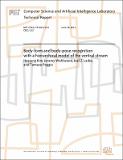| dc.contributor.advisor | Tomaso Poggio | |
| dc.contributor.author | Kim, Heejung | en_US |
| dc.contributor.author | Wohlwend, Jeremy | en_US |
| dc.contributor.author | Leibo, Joel Z. | en_US |
| dc.contributor.author | Poggio, Tomaso | en_US |
| dc.contributor.other | Center for Biological and Computational Learning (CBCL) | en_US |
| dc.date.accessioned | 2013-06-20T17:00:04Z | |
| dc.date.available | 2013-06-20T17:00:04Z | |
| dc.date.issued | 2013-06-18 | |
| dc.identifier.uri | http://hdl.handle.net/1721.1/79354 | |
| dc.description.abstract | When learning to recognize a novel body shape, e.g., a panda bear, we are not misled by changes in its pose. A "jumping panda bear" is readily recognized, despite having no prior visual experience with the conjunction of these concepts. Likewise, a novel pose can be estimated in an invariant way, with respect to the actor's body shape. These body and pose recognition tasks require invariance to non-generic transformations that previous models of the ventral stream do not have. We show that the addition of biologically plausible, class-specific mechanisms associating previously-viewed actors in a range of poses enables a hierarchical model of object recognition to account for this human capability. These associations could be acquired in an unsupervised manner from past experience. | en_US |
| dc.format.extent | 10 p. | en_US |
| dc.relation.ispartofseries | MIT-CSAIL-TR-2013-013 | |
| dc.relation.ispartofseries | CBCL-312 | en_US |
| dc.rights | Creative Commons Attribution-NonCommercial-NoDerivs 3.0 Unported | * |
| dc.rights.uri | http://creativecommons.org/licenses/by-nc-nd/3.0/ | en_US |
| dc.subject | Ventral stream | en_US |
| dc.subject | Modularity | en_US |
| dc.subject | Computational neuroscience | en_US |
| dc.subject | HMAX | en_US |
| dc.title | Body-form and body-pose recognition with a hierarchical model of the ventral stream | en_US |
| dc.date.updated | 2013-06-20T17:00:05Z | |
